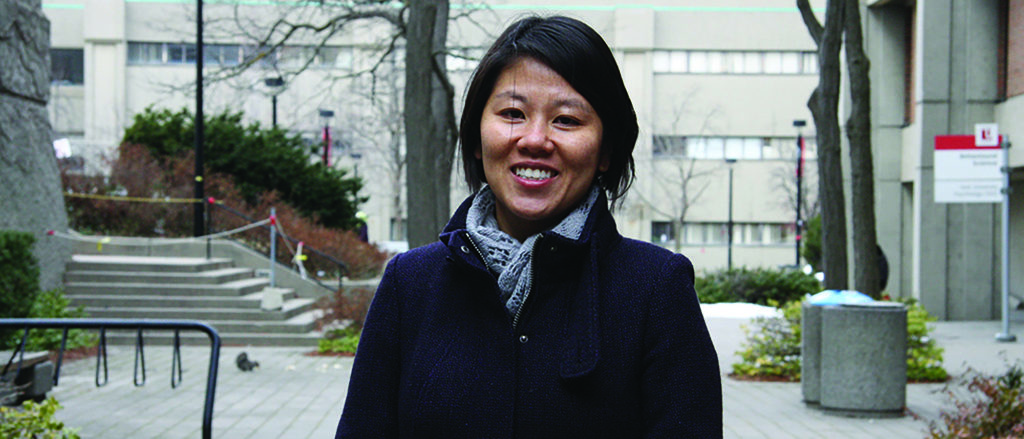First Person
Careers Up Close: Jolynn Pek on Quantifying Uncertainty

Jolynn Pek is an associate professor of quantitative psychology at The Ohio State University. Through her research, Pek analyzes sources of uncertainty in statistical results and develops new approaches to practicing replicable psychological science.
Current role: Associate professor of quantitative psychology at The Ohio State University, 2021–present
Previously: Assistant professor of quantitative psychology at The Ohio State University, 2017–2021
Previously: Assistant Professor of quantitative methods at York University, 2012–2017 Terminal degree: PhD in quantitative psychology from the University of North Carolina at Chapel Hill, 2012
Recognized as APS Rising Star in 2017
Landing the Job
Very many people opened doors for me to be here at The Ohio State University (OSU). When I did my undergraduate degree at the National University of Singapore (NUS), Fredrick T. Leong spent a sabbatical semester there in my 3rd year. I worked on a research project with him that ended in a publication and later completed my honors thesis under the direction of Dr. Weining Chang. This work was focused on traditional and modern Chinese values related to self-identity.
Fred recommended that I work with George Bishop, with whom I did my master’s of applied psychology at NUS. George later spent a sabbatical at Duke University and made it possible for me to be a visiting scholar with the support of Redford Williams at Duke’s Behavioral Medicine Research Center. My research examined the effect of emotions to ambulatory cardiovascular functioning, involving intensive longitudinal data, which introduced me to advanced quantitative methods.
At Duke, I introduced myself to Rick Hoyle because of his work in structural equation modeling and managed to sit in on graduate courses on data analysis and social psychology. Rick also accompanied me to the University of North Carolina at Chapel Hill (UNC), which was in the next small city, to consult experts at the Odum Institute for Research in Social Science about analyzing my master’s data.
While I was exploring what UNC had to offer, I somehow crossed paths with Kristopher Preacher to puzzle through a problem involving statistical mediation. Kris was a postdoc at the time, and after chatting with me about my interests, he recommended that I speak with Bud MacCallum, director of the L. L. Thurstone Psychometric Lab. I met with Bud, was convinced to apply to the graduate program in quantitative psychology, became his student, and the rest is history.
Modeling methods
At the time I became an APS Rising Star, I was moving away from the highly technical work I did for my dissertation on profile likelihood estimation in structural equation modeling and structural equation finite mixture models. Instead, I was drawn to moving methods into practice. This move was motivated by my experience teaching graduate-level quantitative methods. It became clear that future scientists should be equipped with modern methods to conduct better research and that the responsibility for building that bridge rests on quantitative psychologists like myself. To that end, I wrote several papers intended to demonstrate current methodological best practices. One paper emphasized the many ways to report effect sizes; another paper focused on conceptual considerations underlying mediation analysis. I also wrote several papers with Augustine Wong, a statistician, on how to deal with non-normal data from a linear modeling framework.
My focus on bringing methods into practice was also motivated by concerns about the replicability of psychological results. Discussions on how to improve psychological science touched on power analysis, which is a highly abstract topic. My research at OSU, which marks the time right when I become an APS Rising Star, is centered on how to improve power analysis to better reflect complex realities researchers face when conducting a study. Complexities tend to increase uncertainty, and my technical work provided a way to formally incorporate uncertainties in power analysis to obtain calculations that better reflect reality. In collaboration with my non-methods colleagues, especially Duane Wegener, we have started to examine the extent to which power is useful for evaluating research.
Competing ideas
The work we do as intellectual athletes is highly demanding. We put our best ideas out to compete with other ideas. For these ideas to be refined and evolve, they are challenged, questioned, dismissed, and modified. One needs to fully believe in an idea for it to be eventually communicated to others. The route from an idea to a published work and eventual discussion is typically off the beaten path. There will be cycles of failures and successes accompanied by self-doubt and then confidence. This tension is important for developing an eventual robust idea. Stay the course, because doors will open in the form of support from colleagues, mentors, and students. The journey never ceases to be a dramatic adventure, so make sure to have fun along the way.
Everyday outliers
The best part of my job is working with brilliant students and colleagues to puzzle through worthwhile problems. The biggest challenge is having to wear different hats at the same time.





APS regularly opens certain online articles for discussion on our website. Effective February 2021, you must be a logged-in APS member to post comments. By posting a comment, you agree to our Community Guidelines and the display of your profile information, including your name and affiliation. Any opinions, findings, conclusions, or recommendations present in article comments are those of the writers and do not necessarily reflect the views of APS or the article’s author. For more information, please see our Community Guidelines.
Please login with your APS account to comment.